Thursday, August 13th 2020

Intel Delivers Advances Across 6 Pillars of Technology, Powering Our Leadership Product Roadmap
At Intel, we truly believe in the potential of technology to enrich lives and change the world. This has been a guiding principle since the company was founded. It started with the PC era, when technology enabled the mass digitization of knowledge and networking, bringing 1 billion people onto the internet. Then came the mobile and cloud era, a disruption that changed the way we live. We now have over 10 billion devices connected to supercomputers in the cloud.
We believe the next era will be the intelligent era. An era where we will experience 100 billion intelligent connected devices. Exascale performance and architecture will make this intelligence available to all, enriching our lives in more ways than we can imagine today. This is a future that inspires and motivates me and my fellow Intel architects every day.We are generating data at a faster rate than our current ability to analyze, understand, transmit, secure and reconstruct it in real time. Analyzing a ton of data requires a ton of compute. More important, for this data to help us with insights, it needs access to compute in real time, which means low-latency, close to the user. At Intel, we are on a journey to solve this exponentially hard problem.
Since the end of the Dennard scaling era, extracting the exponential value from transistor technology inspired us to look at new approaches across the whole stack. This led us to what we call our Six Pillars of Technology Innovation, which we introduced at our Architecture Day in December 2018. We believe that delivering advances across these pillars is necessary to continue the exponential essence of Moore's Law.
This week, at Architecture Day 2020, we showcased how we are taking this forward with a broad range of exciting new breakthroughs. We have made great progress with our diverse mix of scalar, vector, matrix and spatial architectures - designed with state-of-the-art process technology, fed by disruptive memory hierarchies, integrated into systems with advanced packaging, deployed at hyperscale with lightspeed interconnect links, unified by a single software abstraction, and developed with benchmark defining security features.
We provided more details about our disaggregated design methodology and our advanced packaging roadmap. We demonstrated our mastering of fine bump pitches in EMIB and Foveros technologies through several product iterations in graphics and FPGAs, and on the client with Lakefield.
We also shared one of the most exciting advancements in our transistor roadmap by introducing our new 10 nm SuperFin technology, a redefinition of the FinFET with new SuperMIM capacitors that enables the largest single, intranode enhancement in Intel's history, delivering performance improvements comparable to a full-node transition and enabling a leadership product roadmap.
When we integrate our next-generation Willow Cove CPU architecture with our 10 nm SuperFin technology, the result is the incredible new Tiger Lake platform. We unpacked details of the upcoming Tiger Lake system-on-chip architecture, which provides a generational leap in CPU performance, leadership graphics, leadership artificial intelligence (AI), more memory bandwidth, additional security features, better display, better video and more. I know everyone is eager for all of the details on Tiger Lake and we look forward to sharing more in the coming weeks.
In addition to Tiger Lake, we provided a deep dive into our next generation Intel Agilex FPGA, which provides breakthrough performance per watt. In fact, we showcased two generations of disaggregated products using EMIB and shared the first results of our 224 Gbps transceivers.
We also highlighted how Intel's Xe GPU architecture is the foundation that helps us build GPUs that are scalable from teraflops to petaflops. Xe-LP powers leadership graphics in Tiger Lake and is our most efficient microarchitecture for PC and mobile computing platforms. Xe-LP also powers our first discrete GPU in more than 20 years, codenamed DG1. This GPU is now in production. We also introduced the first Intel server GPU, powered by Xe-LP. This GPU will ship later this year and deliver class-leading stream density and visual quality for media transcode and streaming.
On the data center front, we announced that our first?Xe-HP chip is sampling to customers. Xe-HP is the industry's first multitiled, highly scalable, high-performance GPU architecture, providing petaflop-scale AI performance and rack-level media performance in a single package based on our EMIB technology. Xe-HP will leverage enhanced SuperFin technology.
And, our enthusiast and gamer friends, we heard your requests for Xe for enthusiast gaming. We added a fourth microarchitecture to the Xe family: Xe-HPG optimized for gaming, with many new graphics features including ray tracing support. We expect to ship this microarchitecture in 2021 and I can't wait to get my hands on this GPU!
On software, we have talked before about our vision for providing developers a unified, standards-based programming model across all our XPU architectures. We are executing on that vision with our oneAPI Gold release available later this year. We also announced that we are offering DG1 early access to developers in Intel DevCloud, enabling them start developing with oneAPI without need for any setups, downloads and hardware installs.
Since our last Architecture Day, we have made some big steps in memory. Most recently, as part of the 3rd Gen Intel Xeon Scalable processor launch (code-named "Cooper Lake"), we announced our 2nd Gen Intel Optanepersistent memory product (code-named "Barlow Pass"). We also remain on track to move Intel's 4-bit-per-cell QLC into production by the end of 2020.
We also took a deeper look at how we are advancing security amid a constantly evolving threat landscape. This includes the introduction of new technologies, such Intel Control-Flow Enforcement Technology, which delivers CPU-level security structures to help protect against common malware attack methods. And, we gave the first look at our longer-term vision around foundational security, workload protection and software reliability.
We have made major progress in advancing interconnect, too. Intel announced in March 2019 that it was working with the industry for broad support for Compute Express Link, designed to accelerate next-generation data center performance and to be offered in Sapphire Rapids. We have also had a significant lead with silicon photonics in terms of customer engagements, and as the data center continues its transformation, Intel is addressing their needs through leadership speeds and foundational and SmartNIC products for network processing offloads.
Our Intel fellows and architects are passionately working on technology for 2021, 2022 and beyond. We provided a glimpse into our product vision for client and data center leveraging for all six pillars and disaggregated design. Our head of Intel Labs also provided a look at where emerging research areas can get us 100x to 1000x improvements in compute efficiency, including a sneak peek at neuromorphic architectures being researched in our world-leading labs.
For decades, Intel has been at the center of the technology industry. Our products, along with those of our customers, have reshaped the way we all work, live and play. But our collective journey is far from over. I believe we are at the start of a new era, an intelligent era, an exascale for everyone era. This era will be powered by unprecedented levels of compute performance and disruptions across all Six Pillars of Technology Innovation.
The complete slide deck follows.
We believe the next era will be the intelligent era. An era where we will experience 100 billion intelligent connected devices. Exascale performance and architecture will make this intelligence available to all, enriching our lives in more ways than we can imagine today. This is a future that inspires and motivates me and my fellow Intel architects every day.We are generating data at a faster rate than our current ability to analyze, understand, transmit, secure and reconstruct it in real time. Analyzing a ton of data requires a ton of compute. More important, for this data to help us with insights, it needs access to compute in real time, which means low-latency, close to the user. At Intel, we are on a journey to solve this exponentially hard problem.
Since the end of the Dennard scaling era, extracting the exponential value from transistor technology inspired us to look at new approaches across the whole stack. This led us to what we call our Six Pillars of Technology Innovation, which we introduced at our Architecture Day in December 2018. We believe that delivering advances across these pillars is necessary to continue the exponential essence of Moore's Law.
This week, at Architecture Day 2020, we showcased how we are taking this forward with a broad range of exciting new breakthroughs. We have made great progress with our diverse mix of scalar, vector, matrix and spatial architectures - designed with state-of-the-art process technology, fed by disruptive memory hierarchies, integrated into systems with advanced packaging, deployed at hyperscale with lightspeed interconnect links, unified by a single software abstraction, and developed with benchmark defining security features.
We provided more details about our disaggregated design methodology and our advanced packaging roadmap. We demonstrated our mastering of fine bump pitches in EMIB and Foveros technologies through several product iterations in graphics and FPGAs, and on the client with Lakefield.
We also shared one of the most exciting advancements in our transistor roadmap by introducing our new 10 nm SuperFin technology, a redefinition of the FinFET with new SuperMIM capacitors that enables the largest single, intranode enhancement in Intel's history, delivering performance improvements comparable to a full-node transition and enabling a leadership product roadmap.
When we integrate our next-generation Willow Cove CPU architecture with our 10 nm SuperFin technology, the result is the incredible new Tiger Lake platform. We unpacked details of the upcoming Tiger Lake system-on-chip architecture, which provides a generational leap in CPU performance, leadership graphics, leadership artificial intelligence (AI), more memory bandwidth, additional security features, better display, better video and more. I know everyone is eager for all of the details on Tiger Lake and we look forward to sharing more in the coming weeks.
In addition to Tiger Lake, we provided a deep dive into our next generation Intel Agilex FPGA, which provides breakthrough performance per watt. In fact, we showcased two generations of disaggregated products using EMIB and shared the first results of our 224 Gbps transceivers.
We also highlighted how Intel's Xe GPU architecture is the foundation that helps us build GPUs that are scalable from teraflops to petaflops. Xe-LP powers leadership graphics in Tiger Lake and is our most efficient microarchitecture for PC and mobile computing platforms. Xe-LP also powers our first discrete GPU in more than 20 years, codenamed DG1. This GPU is now in production. We also introduced the first Intel server GPU, powered by Xe-LP. This GPU will ship later this year and deliver class-leading stream density and visual quality for media transcode and streaming.
On the data center front, we announced that our first?Xe-HP chip is sampling to customers. Xe-HP is the industry's first multitiled, highly scalable, high-performance GPU architecture, providing petaflop-scale AI performance and rack-level media performance in a single package based on our EMIB technology. Xe-HP will leverage enhanced SuperFin technology.
And, our enthusiast and gamer friends, we heard your requests for Xe for enthusiast gaming. We added a fourth microarchitecture to the Xe family: Xe-HPG optimized for gaming, with many new graphics features including ray tracing support. We expect to ship this microarchitecture in 2021 and I can't wait to get my hands on this GPU!
On software, we have talked before about our vision for providing developers a unified, standards-based programming model across all our XPU architectures. We are executing on that vision with our oneAPI Gold release available later this year. We also announced that we are offering DG1 early access to developers in Intel DevCloud, enabling them start developing with oneAPI without need for any setups, downloads and hardware installs.
Since our last Architecture Day, we have made some big steps in memory. Most recently, as part of the 3rd Gen Intel Xeon Scalable processor launch (code-named "Cooper Lake"), we announced our 2nd Gen Intel Optanepersistent memory product (code-named "Barlow Pass"). We also remain on track to move Intel's 4-bit-per-cell QLC into production by the end of 2020.
We also took a deeper look at how we are advancing security amid a constantly evolving threat landscape. This includes the introduction of new technologies, such Intel Control-Flow Enforcement Technology, which delivers CPU-level security structures to help protect against common malware attack methods. And, we gave the first look at our longer-term vision around foundational security, workload protection and software reliability.
We have made major progress in advancing interconnect, too. Intel announced in March 2019 that it was working with the industry for broad support for Compute Express Link, designed to accelerate next-generation data center performance and to be offered in Sapphire Rapids. We have also had a significant lead with silicon photonics in terms of customer engagements, and as the data center continues its transformation, Intel is addressing their needs through leadership speeds and foundational and SmartNIC products for network processing offloads.
Our Intel fellows and architects are passionately working on technology for 2021, 2022 and beyond. We provided a glimpse into our product vision for client and data center leveraging for all six pillars and disaggregated design. Our head of Intel Labs also provided a look at where emerging research areas can get us 100x to 1000x improvements in compute efficiency, including a sneak peek at neuromorphic architectures being researched in our world-leading labs.
For decades, Intel has been at the center of the technology industry. Our products, along with those of our customers, have reshaped the way we all work, live and play. But our collective journey is far from over. I believe we are at the start of a new era, an intelligent era, an exascale for everyone era. This era will be powered by unprecedented levels of compute performance and disruptions across all Six Pillars of Technology Innovation.
The complete slide deck follows.

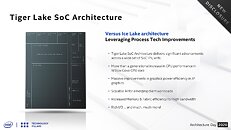







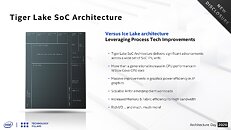

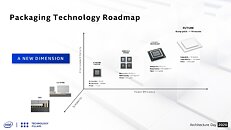


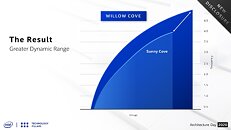
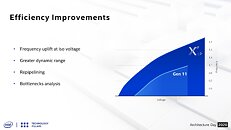
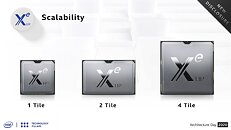







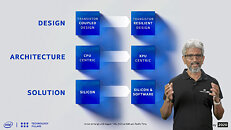
39 Comments on Intel Delivers Advances Across 6 Pillars of Technology, Powering Our Leadership Product Roadmap
Fire this lead and return engineers to their position. They need more recognition, not steve jobs promotion.He plays it safe.
www.wsj.com/amp/articles/intel-chief-engineer-departs-after-product-delay-11595886781
Even now, fist deep into consoles they are still behind more than a full gen, even lacking key features. Is that competitive? Dunno, but I do know selling GPUs at a discount is not really an achievement. Another shocker is that they've still not realized a single GPU release with timely and good AIB cards along with their reference junk.
So its certainly not 'being wrong', at the very best its a matter of perspective.
two generations have largely gone unanswered? which would those be (im refering to the list of GPU's I mentioned)? and the ATI merger....jeez let that go, we were talking about the last decade here.
What "key features" are they lacking...and dont even think to mention something silly like "ray tracing" as you know as well as I that that was a rocky start and even now its barely relevant and wont be untill all parties can play along with it otherwise its just sponsored by Nvidia and no different from a console exclusive really.
But I will say their reference boards are top notch, the cooler's are the only let down.
I'm getting worried about Intel.
Two generations? Pascal and Turing, and realistically, also Maxwell's 980ti. It was since that moment that AMD lost leadership definitively and they still bleed for it. During Pascal all they had was a Vega with spotty availability, and a rebadged Polaris card or two that got bought up by miners. Meanwhile, Nvidia could keep channels stocked with a full range of GPUs and ALSO sales from mining. Turing: AMD brings us an RX Navi product that even today is not up to par and still suffers from shit drivers. We still haven't seen the first semblance of a GPU that can do RT. Its not a key feature because the competition doesn't have it, is what you are literally saying. Euhm.... yeah. Surely you can see the problem with that logic, and even so... its still a key feature that AMD is missing, because the moment they also implement it, that is what they are admitting to. You are somehow denying that is true. Nice bit of mental gymnastics.
Furthermore, you can argue all day but the numbers don't lie. AMD is trailing, in technology, in market share and in overall share price, and they are floating mostly on CPU and not GPU, now more than they probably ever have, despite a long term console deal AND a node advantage. Oh yeah! For the gamers!
4 more years is...4 more years, that is not what we were talking about.
Vega 56 like i mentioned was a better option then the nearest Nvidia card and the r9 290/390 was a better purchase then the GTX970.
How did AMD lose leadership, what do you call leadership? having the fastest card out there? orr selling the most because yeah Nvidia has a solid marketing team and legion of fanboys that will always blame AMD for any PC issues (untill recently that included processors as well) and say people should buy Nvidia, and Nvidia is probably like intel properly intrenged with a lot of the pre-build sellers like Dell.
Both companies's cards were bought up like mad by miners during that one period and that rebadged Polaris card, Rx480/580/590 were great cards and again a really good competitor for the GTX1060.
How is RX Navi not up to par..... up to par with what? the RTX2060 Super? because it is....and its often a better purchase, I will give you driver issues, even Gamers Nexus talks about that.
I specifically mentioned not talking about Ray Tracing, you cant seriously claim its important, its not, it will however soon tm and then AMD will have the cards for it and the consoles as well and only BECAUSE AMD will have the hardware ready by then.
Now its not a key feature because only a handful of companies that get money shoved there way are using it, this is like PhysX, the actual proper usage of it was watered down to some extra shenanigans in a handful of games, because nobody would make a game that can only be run on Nvidia cards, the sales would be terrible, again this is why I mentioned console exclusives because Sony for examples PAYS companies to pretty much make up the difference so the game is a console seller.
Likewise nobody seriously has build games fully made with RT because RT is not there yet and 70% of the market out there cant do it, so its just this tacket on feature for most games and not a selling point apart from technerds who love testing this sort of thing.
And that last bit ,you act as if Nvidia invented ray tracing instead of it being in use for what? 2 decades now but just has not been able to be done in real time, Nvidia opened that door (once again I might add) and yeah others will then also with their version of it, heck might be superior and THEN games can be made fully using the tech and we can advance in that area, not prior.
Yep AMD is not selling as much as Big N, I would argue that has more to do with shady practices behind the scenes then anything else, Intel is also still huge even though they do shady stuff as well soooo yeah, welcome to the real world, money makes money and Nvidia has a lot more of it,
Caselabs vs Thermaltake, Thermaltake steals their designs, Caselabs sues and get run into the ground by the infinitely larger company that can sue to infinity, guess Thermaltake is the better company and Caselabs was just not competing or competent....
And obviously AMD currenly invests in what works, they have limited node availability so that goes first and formost to the CPU's that are established and populair.
But to wrap it all up, AMD has a history of excellent videocards that can and does last users for a long time and provide excellent competition, what Nvidia fanboys always conveiniently like to do is just forget all those cards that were the better options in the past and forget all the stumbling blocks big N fell over painting a picture as if AMD always has and had driver issues and big N is perfect, this is just, again, wrong.